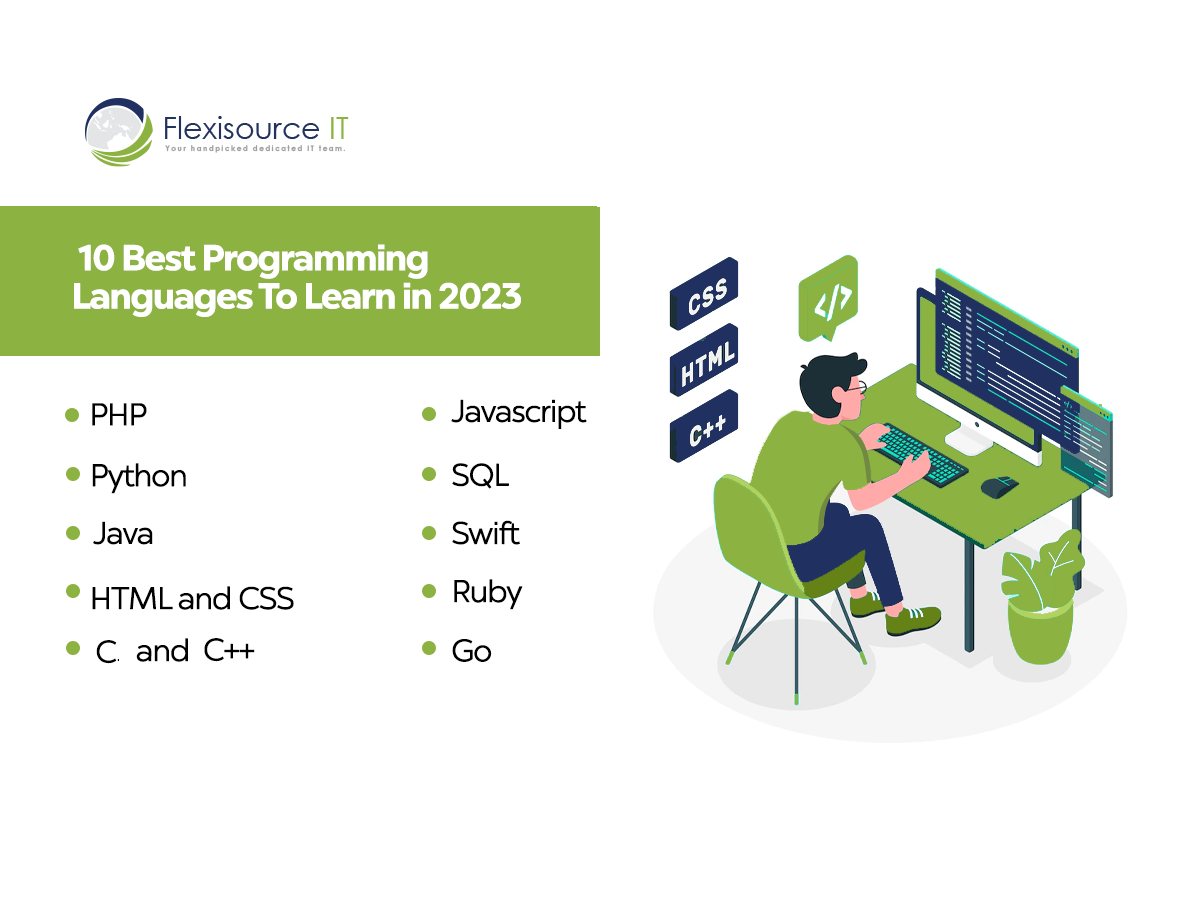If you are thinking of venturing into an IT career path, you wouldn’t want to waste your time learning unnecessary programming languages. You want to ensure that the first programming language you understand is in demand and relevant in the market. After all, you will use it for the rest of your career.
There is no right or wrong answer when choosing your first programming language. It highly depends on the type of project you want to work on, your interests, learning flexibility, and existing skills.
Likewise, to help you choose between the vast number of programming languages, this article will tackle the ten best programming languages you should know in 2023.
Table of Contents
10 Best Programming Languages to Learn in 2023

1. PHP
PHP is a general-purpose scripting language that is especially suited to web development. It can be embedded into HTML, allowing web developers to create dynamic web pages. Moreover, this programming language is among the most popular online languages, powering about 80% of all websites.
Likewise, here are the features of the PHP programming language:
- Easy to learn
- Simple syntax
- Open source and free to use, even for larger-scale projects
- Developers can use it on any platform such as desktop, mobile, and web
- Big community with tons of resources and tutorials online
2. Python
Python is a programming language created in 1989 by Guido van Rossum. It has a simple syntax, and it is easy to learn. Python is an introductory language in some colleges and universities. Still, Developers can also use it for web development, data science, machine learning, and more.
In addition, this programming language is open-source, meaning the program’s code is available for people to read and modify. It allows programmers to share their code with others to improve on it and make new programs from it.
Here are some features of Python:
- Easy to learn and great for beginners
- Developers can use it in web and desktop applications
- Increasing popularity with developers and companies
- Flexible and easy to scale
- Open source and free to use
3. Java
Java is a programming language that Sun Microsystems developed in 1995. It is one of the most popular programming languages and the first language to support object-oriented programming. In addition, Java is a general-purpose, high-level, concurrent, class-based, object-oriented language that developers can use to develop many types of applications.
Here are the top features of this programming language:
- Easy to learn with simple syntax
- Robust and helps developers eliminate error-prone codes
- Platform independent, guaranteed to be written once, run-anywhere language
- Functional Interfaces and Lambda Expression
- Object-oriented programming language
4. HTML and CSS
HTML and CSS are the two languages that are used to create websites. HyperText Markup Language or HTML is a markup language that defines the content and structure of a web page. Likewise, here are some features of HTML:
- Easy to learn and use
- Platform-independent, even on mobile, browser, or desktop platforms.
- Allows developers to add media such as images, videos, and audio to the webpage
On the other hand, Cascading Style Sheets or CSS is a style sheet language that describes how the web page should look. Here are also the top features of CSS:
- Developers can easily change elements such as color, gradients, etc.
- User-friendly, beginners can easily use it
- Provides many interfaces features such as resizing elements and more
5. C and C++
C is probably one of the oldest programming languages. It is a general-purpose programming language initially developed by Dennis Ritchie. C is one of the most widely used programming languages in various operating systems, including Linux and Mac OS. Here are some of the best features of C.
- Simple and efficient boasts basic syntax that is easy to learn
- Compilation and execution of codes are faster since it’s a statistically typed programming language
- Highly portable and machine-independent
- It comes with dynamic memory management with several predefined functions
- Now supports features of high-level programming languages
C++, on the other hand, is an enhanced version of C. This programming language is an object-oriented programming language created by Bjarne Stroustrup as an extension of C. It was designed to make it efficient for high-level applications where performance was more important than ease of use or consistency. Likewise, it adds features related to object-oriented programs, such as classes, abstract data types, and inheritance. Here are some of its top features:
- Platform independent
- Rich library with tons of in-built functions
- Supports dynamic memory allocation
- Fast compilation and execution
6. JavaScript
JavaScript is a programming language that most developers use for web development to create interactive effects and animations on websites. It also makes it easier for developers to create interactive effects and animations within the browser.
Moreover, this programming language has become one of the most popular languages for web development, with over half of all sites using at least some JavaScript in their codebase.
Here are some of its features:
- Lightweight scripting language
- Object-oriented programming support
- Highly platform independent
- Features client-side technology that can perform the basic calculation on the user’s browser
7. SQL
SQL or Structured Query Language was initially developed by Donald D. Chamberlin and Raymond F. Boyce in the 1970s at IBM for the company’s System R database management system. This programming language ran on top of the company’s mainframe computers using batch processing.
Since then, SQL has been a computer language used to create, read, and update databases. It is a programming language used to access and manipulate data in databases. Likewise, this programming language boasts the following features such as:
- Embedding host languages such as Java, C, and Cobol
- Can support and retrieve a large amount of data
- Highly scalable, you can increase the load on a single server by adding more memory
- Contains various security-enabling
- Includes authentication to identify a user or person based on their username and password
8. Swift
Swift is a programming language developed by Apple Inc. in 2014. It is a successor to the Objective-C programming language. Developers can use this programming language to create apps for iOS and macOS. Moreover, Swift has many features that make it an attractive programming language for developers, such as the following:
- High-level abstractions
- Automatic memory management, which is not available in Objective-C
- Clean and easy-to-read syntax
9. Ruby
Ruby is a dynamic, reflective, general-purpose, object-oriented programming language. It was designed and developed in the mid-1990s by Yukihiro “Matz” Matsumoto in Japan. In addition, this programming language supports multiple programming paradigms: functional, object-oriented, and imperative.
Ruby is a general-purpose programming language for developing web applications or desktop apps. The best features of Ruby are:
- Elegant syntax, simple to learn for new programmers and nonprogrammers alike
- Supports functional and imperative programming styles
- Large standard library
- Sustains multiple programming paradigms
10. Go
Go is a programming language that was created at Google in 2007. It is a compiled, statically typed, garbage collected language with C-like syntax. Go was designed to make programming more accessible, productive, and fun.
Likewise, the best features of the Go programming language are its simplicity and the fact that it has no runtime errors. All programs written in Go are compiled ahead of time. Moreover, the compiler ensures that developers can catch all errors before executing the program.
Ready to learn your programming language?
Whether an established developer or a fresh IT graduate, learning a new programming language will take time, but as long as you have persistence, patience, and perseverance, you can start a career path in IT and development.
As such, we hope that this list will help you in your IT career journey. And if you are looking to jumpstart your career, Flexisource IT is hiring! Check our career page now!
Pamela is a full-time content writer and a lifelong Philomath. Her previous experience as a research analyst made her passionate about traveling the world and understanding how it works. During her day off, you can often find her indoors, writing stories or oil painting.


